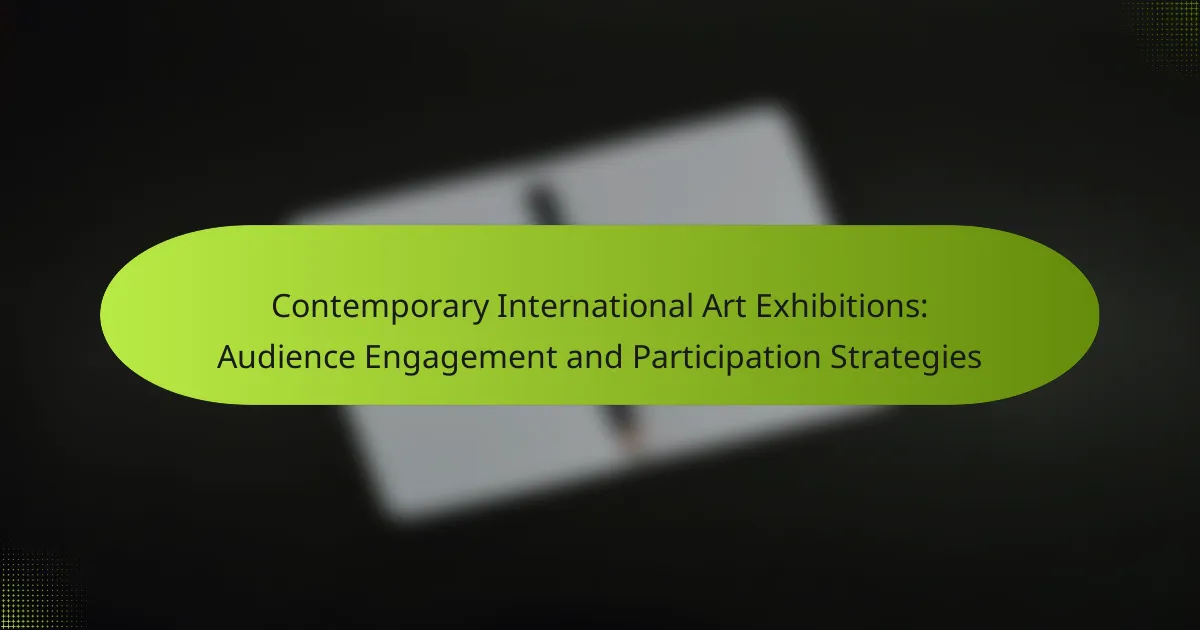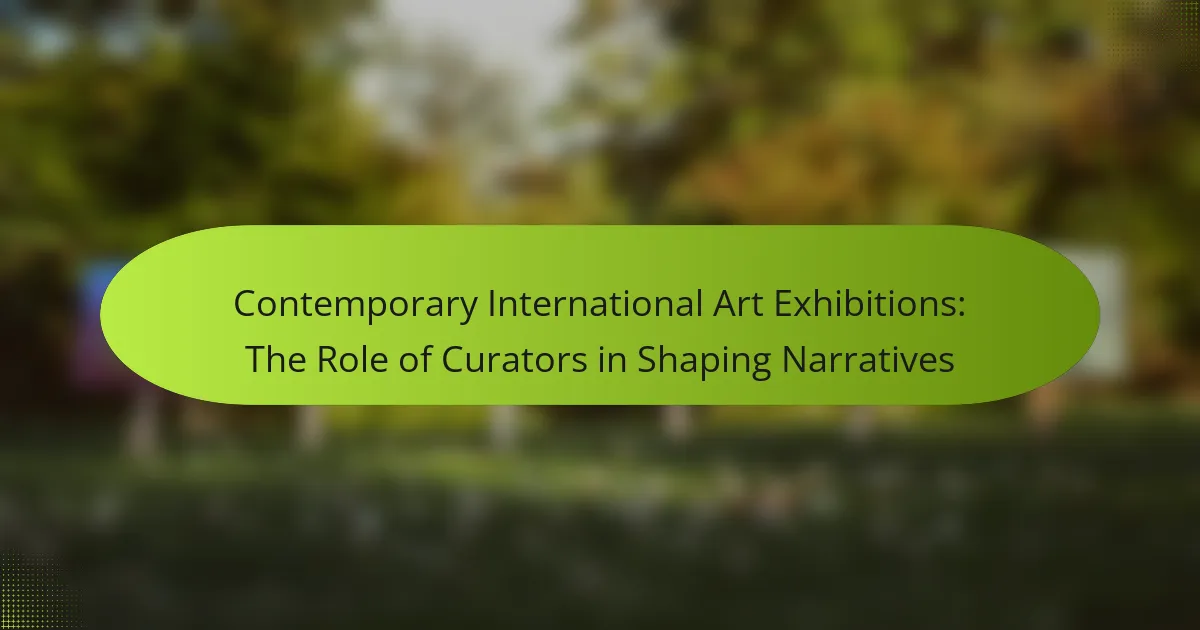Contemporary international art exhibitions play a crucial role in fostering cross-cultural collaborations and exchanges. They create platforms for dialogue among diverse artists and audiences, showcasing innovative projects that blend artistic practices. These exhibitions leverage technology to enhance accessibility and engagement, while addressing the challenges of curation and representation. Additionally, they significantly impact local art scenes, enriching artistic perspectives and promoting economic growth through increased visibility and tourism.
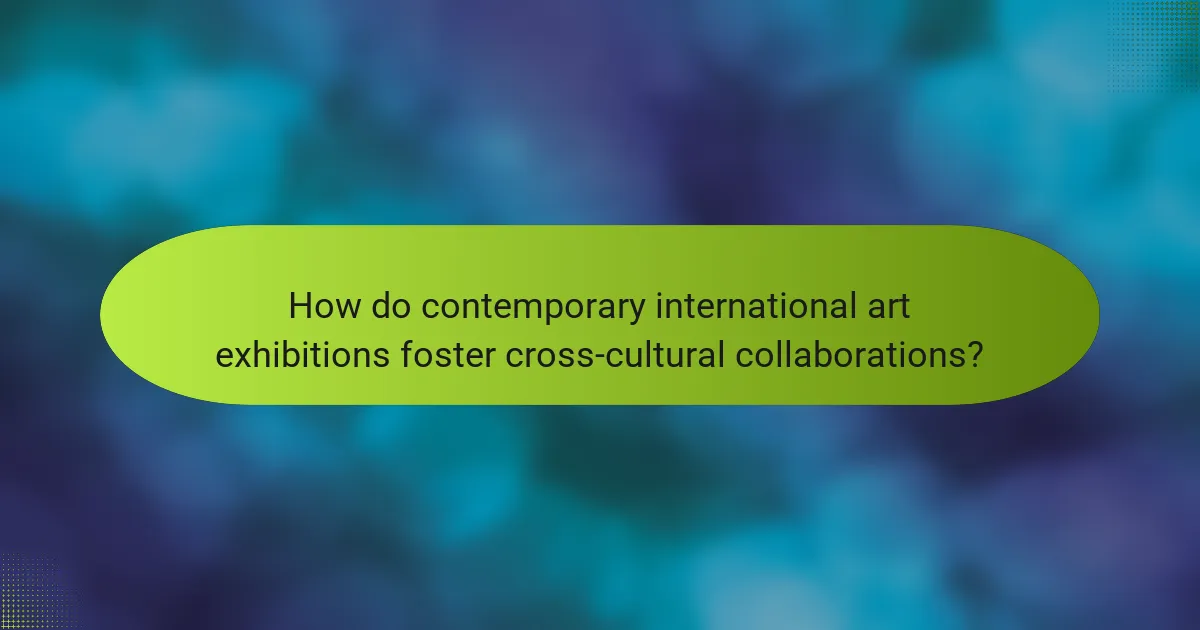
How do contemporary international art exhibitions foster cross-cultural collaborations?
Contemporary international art exhibitions foster cross-cultural collaborations by creating platforms for dialogue and exchange. These exhibitions connect diverse artists, curators, and audiences, promoting understanding and appreciation of different cultures.
They often feature collaborative projects that blend artistic practices, showcasing unique perspectives and innovative ideas. For example, exhibitions like the Venice Biennale highlight works from various countries, encouraging participants to engage with global themes.
Such events also facilitate networking opportunities, allowing artists to form partnerships that transcend geographical boundaries. As a result, these collaborations lead to enriched artistic expressions and foster a sense of global community.
Moreover, contemporary exhibitions often incorporate educational programs that emphasize cultural exchange, further enhancing the collaborative spirit within the art world.
What are the key motivations behind cross-cultural exchanges in art?
Key motivations behind cross-cultural exchanges in art include fostering understanding, promoting diversity, and enhancing creativity. Artists seek to connect with global audiences, share unique perspectives, and challenge cultural boundaries. These exchanges often lead to collaborative projects that enrich the artistic landscape and encourage dialogue among different cultures. Additionally, they provide opportunities for artists to explore new techniques and influences, ultimately contributing to the evolution of contemporary art.
Which organizations are leading the way in international art collaborations?
Leading organizations in international art collaborations include the Venice Biennale, Documenta, and Art Basel. These institutions foster cross-cultural exchanges through exhibitions and programs. The Venice Biennale showcases diverse artists from around the world, emphasizing contemporary themes. Documenta, held in Kassel, Germany, focuses on innovative art practices, promoting dialogue among cultures. Art Basel connects galleries, artists, and collectors globally, facilitating collaborations and networking. Each organization plays a unique role in advancing international artistic collaboration.
How do artists benefit from participating in international exhibitions?
Artists gain visibility, networking opportunities, and cultural exchange through international exhibitions. These platforms showcase diverse artistic expressions, allowing artists to reach global audiences. Participation fosters collaboration, enhances creative skills, and can lead to sales or commissions. Additionally, exposure to different cultures inspires innovation and broadens artistic perspectives.
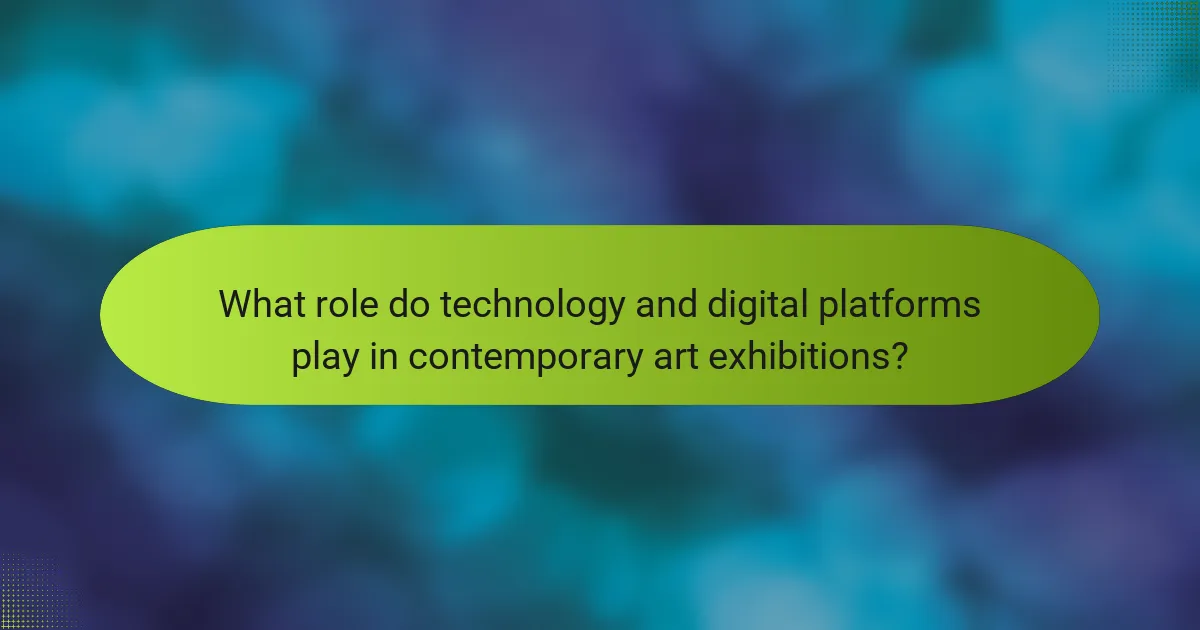
What role do technology and digital platforms play in contemporary art exhibitions?
Technology and digital platforms significantly enhance contemporary art exhibitions by facilitating cross-cultural collaborations and exchanges. They enable artists to reach global audiences, allowing diverse expressions and interactions. Virtual reality and augmented reality create immersive experiences, transforming how viewers engage with art. Additionally, social media platforms amplify outreach, fostering community dialogue and participation. These tools democratize access to art, breaking geographical barriers and promoting inclusivity in the art world.
How has virtual reality transformed the exhibition experience?
Virtual reality has significantly transformed the exhibition experience by enhancing visitor engagement and interaction. It allows audiences to immerse themselves in art, bridging geographical gaps in contemporary international art exhibitions.
Through virtual reality, artists can create immersive environments that reflect cross-cultural collaborations, offering unique perspectives that traditional exhibitions may lack. This technology enables viewers to experience art from various angles, fostering deeper connections with the artwork.
Moreover, virtual reality facilitates remote participation, allowing individuals from diverse backgrounds to experience exhibitions in real-time. This accessibility promotes inclusivity and encourages cultural exchanges, enriching the global art community.
Overall, virtual reality is redefining how art is experienced, making exhibitions more dynamic and interactive while fostering a sense of global unity among artists and audiences.
Which digital tools enhance cross-cultural engagement in art?
Digital tools that enhance cross-cultural engagement in art include virtual reality, social media platforms, and collaborative online galleries. These tools facilitate global connections and foster diverse artistic expressions.
Virtual reality enables immersive experiences that allow viewers to engage with art from different cultures. Social media platforms provide artists a space to share their work and interact with a global audience. Collaborative online galleries showcase diverse artworks and promote cross-cultural dialogue.
Additionally, digital storytelling tools create narratives that highlight cultural contexts, enriching the viewer’s understanding. These technologies contribute to the evolving landscape of contemporary international art exhibitions, emphasizing collaboration and exchange.
What are the implications of online exhibitions for global audiences?
Online exhibitions significantly expand access to contemporary international art for global audiences. They foster cross-cultural collaborations, allowing diverse perspectives to converge and enrich artistic dialogue. Virtual platforms eliminate geographical barriers, enabling participation from varied demographics. This inclusivity promotes a broader understanding of artistic expressions and cultural narratives. Furthermore, online exhibitions can enhance audience engagement through interactive features, making art more accessible and relatable. The implications extend beyond art appreciation, influencing cultural exchange and global discourse.
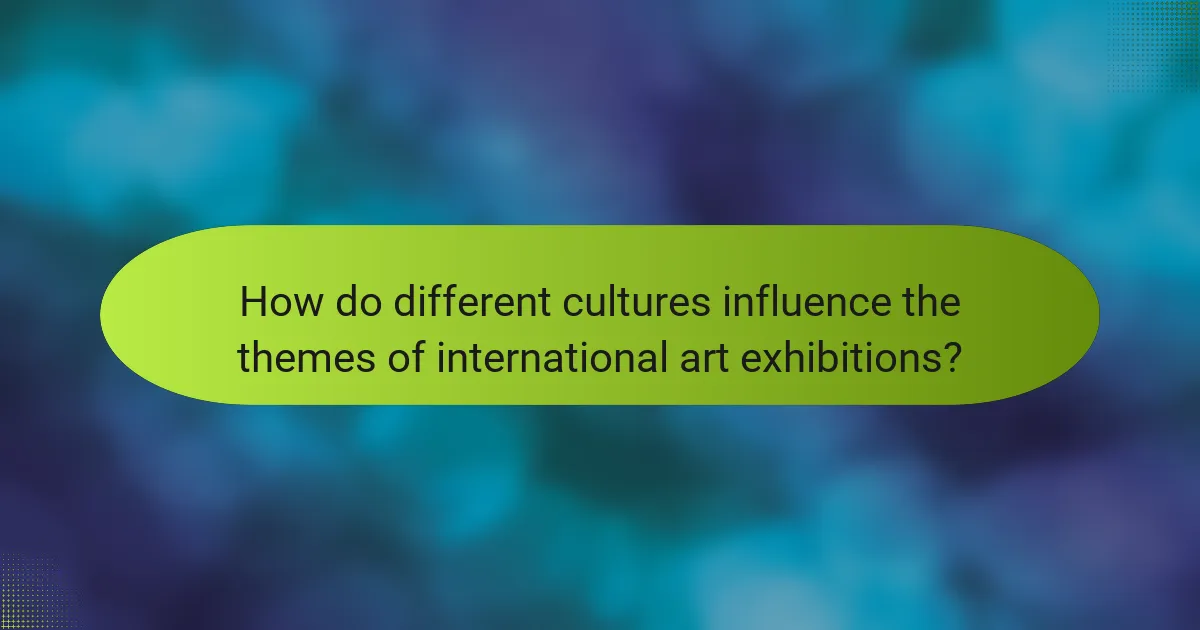
How do different cultures influence the themes of international art exhibitions?
Different cultures significantly shape the themes of international art exhibitions by introducing diverse perspectives and narratives. Cultural influences manifest through artistic styles, historical contexts, and social issues. For example, exhibitions may highlight indigenous practices, contemporary social movements, or traditional techniques, creating a rich tapestry of global dialogue. This cross-cultural exchange fosters understanding and appreciation, revealing unique attributes of each culture while addressing universal themes like identity and resilience. As a result, international art exhibitions become platforms for collaboration and cultural celebration, enhancing global interconnectedness.
What themes are commonly explored in cross-cultural art exhibitions?
Cross-cultural art exhibitions commonly explore themes of identity, migration, cultural exchange, social justice, and globalization. These themes reflect the interconnectedness of diverse cultures and highlight the impact of societal issues on artistic expression.
For example, identity is often examined through personal narratives that challenge stereotypes. Migration themes may address displacement and the search for belonging. Social justice is frequently represented through art that critiques power structures and advocates for change.
Globalization influences artists by merging traditional and contemporary practices, leading to innovative collaborations. These exhibitions foster dialogue and understanding among different cultures, enriching the global art landscape.
How do cultural narratives shape the presentation of artwork?
Cultural narratives significantly influence how artwork is presented in contemporary international exhibitions. They shape themes, aesthetics, and audience engagement, reflecting diverse perspectives.
Exhibitions often highlight cultural stories, fostering cross-cultural collaborations. For instance, artists may reinterpret traditional motifs within modern contexts, creating dialogues between heritage and innovation.
These narratives can also determine the selection of artworks, emphasizing social issues or historical events relevant to specific cultures. As a result, the presentation becomes a medium for cultural exchange and understanding, bridging gaps between different communities.
Moreover, the interpretation of artwork is influenced by cultural narratives, affecting viewer perception and emotional response. This dynamic interaction enriches the exhibition experience, making it a platform for shared narratives and collective reflection.
Which artists are recognized for their unique cultural perspectives in international exhibitions?
Artists recognized for their unique cultural perspectives in international exhibitions include Ai Weiwei, Yoko Ono, and El Anatsui. These artists reflect diverse backgrounds and experiences, enriching global dialogues.
Ai Weiwei’s installations often critique political issues, while Yoko Ono’s work emphasizes peace and social justice. El Anatsui transforms materials into stunning sculptures that explore African identity and history. Their contributions exemplify the power of art in bridging cultural divides.
These artists frequently participate in major international exhibitions, such as the Venice Biennale and Documenta, showcasing their innovative approaches to contemporary themes. Their works invite audiences to engage with complex cultural narratives, fostering understanding and appreciation across borders.
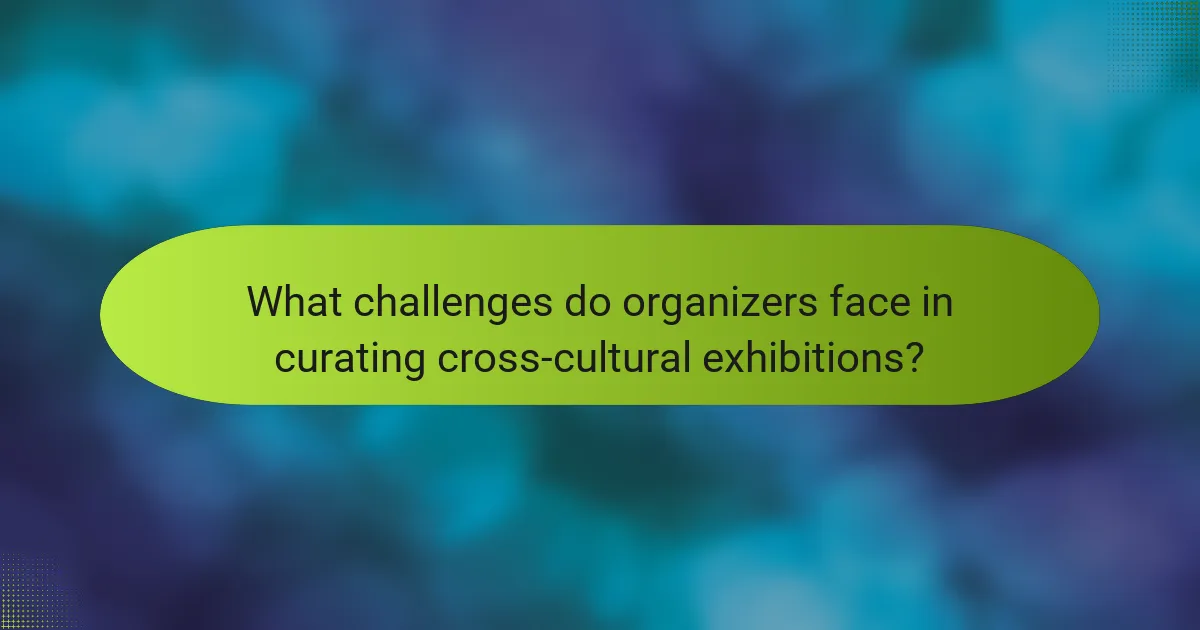
What challenges do organizers face in curating cross-cultural exhibitions?
Organizers face several challenges in curating cross-cultural exhibitions. These include balancing diverse artistic perspectives, navigating cultural sensitivities, and ensuring equitable representation.
Additionally, logistical issues such as language barriers and differing exhibition practices complicate collaboration. Budget constraints can limit the scope of projects, affecting the quality and reach of the exhibitions.
Effective communication among international partners is crucial but often hindered by time zone differences and varying cultural norms.
Finally, securing funding and sponsorships can be challenging, especially when addressing multiple cultural contexts and audiences.
How do logistical issues affect the success of international art exhibitions?
Logistical issues significantly hinder the success of international art exhibitions. Poor transportation, inadequate venue facilities, and customs delays can disrupt timelines and damage artworks. Effective planning and communication are essential to mitigate these challenges. For example, securing reliable shipping partners ensures timely delivery and preservation of art pieces. Additionally, cultural misunderstandings can complicate collaborations, emphasizing the need for thorough local knowledge.
What are the common cultural sensitivities that curators must navigate?
Curators must navigate various cultural sensitivities, including respect for local traditions, understanding historical contexts, and avoiding stereotypes. Acknowledging diverse perspectives is essential for fostering meaningful dialogues. For example, curators should be aware of the significance of specific symbols and practices in different cultures. Additionally, engaging local communities can enhance the relevance and authenticity of exhibitions.
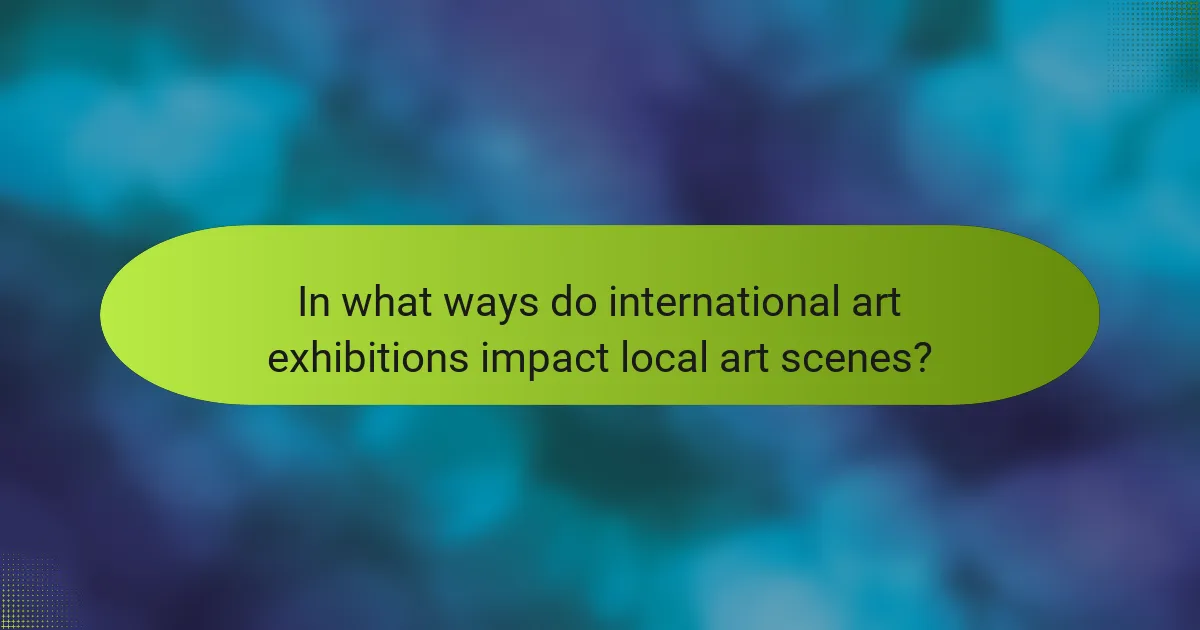
In what ways do international art exhibitions impact local art scenes?
International art exhibitions significantly enhance local art scenes by fostering cultural exchange and collaboration. These events introduce diverse artistic practices and ideas, enriching local artists’ perspectives.
Furthermore, international exhibitions often attract global audiences, increasing visibility for local artists. This exposure can lead to new opportunities, including partnerships and sales.
In addition, such exhibitions can inspire local art institutions to innovate and adapt, creating a dynamic environment for artistic growth. They encourage dialogue between artists and audiences, bridging cultural gaps.
Lastly, the economic impact of increased tourism and engagement can provide vital support for local art initiatives, ensuring their sustainability and development.
How do exhibitions promote local artists alongside international talent?
Exhibitions promote local artists by providing a platform for visibility alongside international talent. They foster cross-cultural collaborations, allowing local creators to engage with diverse artistic perspectives. This exposure enhances their networks and encourages artistic growth. Additionally, local artists gain recognition, which can lead to opportunities in larger markets.
What economic benefits arise from hosting international art events?
Hosting international art events generates significant economic benefits, including increased tourism, job creation, and local business stimulation. These exhibitions attract visitors who contribute to the local economy through spending on accommodations, dining, and entertainment.
Moreover, art events often lead to enhanced visibility for the host city, attracting future investments and cultural initiatives. For instance, cities like Venice and Basel have seen long-term economic growth and increased global recognition due to their art fairs.
Additionally, these events foster cross-cultural collaborations, driving innovation in the local art scene and creating networking opportunities for artists and curators. As a result, the local community gains access to diverse artistic expressions and practices, enriching the cultural landscape.
In summary, international art exhibitions serve as catalysts for economic development, cultural exchange, and community engagement, ultimately enhancing the host city’s profile and vitality.
How do local communities engage with global art trends through exhibitions?
Local communities engage with global art trends through exhibitions by showcasing diverse cultural expressions and fostering dialogue. These exhibitions often feature international artists, creating cross-cultural collaborations that enrich local art scenes. By hosting events, communities can attract global audiences and promote local talent, enhancing cultural exchange. Additionally, local insights can influence global art trends, making these exhibitions a two-way street of artistic influence.
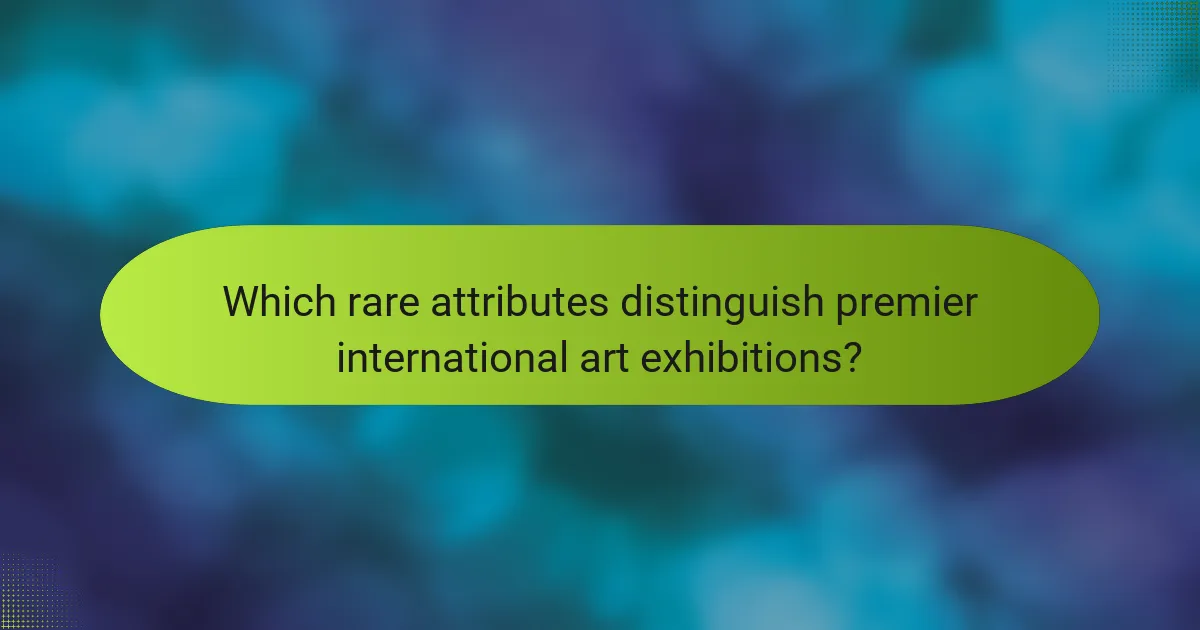
Which rare attributes distinguish premier international art exhibitions?
Premier international art exhibitions are distinguished by their unique attributes, including innovative curatorial practices, emphasis on cultural dialogue, and engagement with emerging artists. These exhibitions often feature collaborative projects that transcend geographical boundaries, showcasing diverse perspectives. Additionally, the integration of technology and interactive elements enhances audience participation, creating immersive experiences. Rarely, exhibitions may include exclusive commissions or site-specific installations, further setting them apart in the global art landscape.
What unique experiences can attendees expect at exclusive art events?
Attendees at exclusive contemporary international art exhibitions can expect immersive experiences that foster cross-cultural collaborations. These events often showcase unique artworks and installations that reflect diverse perspectives. Interactive workshops and discussions with artists enhance engagement, promoting deeper understanding of artistic practices. Networking opportunities with global creatives can lead to future collaborations. Exclusive previews and private tours provide intimate access to groundbreaking works, enriching the overall experience.
How do certain exhibitions create lasting legacies in the art world?
Contemporary international art exhibitions create lasting legacies through cross-cultural collaborations and exchanges. These exhibitions foster dialogue between diverse artistic practices, influencing future generations of artists. They often introduce new perspectives and techniques, reshaping the global art narrative. Notable examples include the Venice Biennale and Documenta, which have established platforms for underrepresented voices, enhancing cultural appreciation and understanding.
What innovations have emerged from notable art exhibitions in recent years?
Recent notable art exhibitions have introduced innovative approaches to cross-cultural collaborations and exchanges. These events have fostered global dialogues, showcasing diverse artistic practices and addressing social issues.
One significant innovation is the integration of technology, such as virtual reality and augmented reality, enhancing audience engagement. For instance, the use of immersive installations has transformed traditional viewing experiences into interactive journeys.
Another emerging trend is the focus on sustainability and social responsibility. Many exhibitions now highlight eco-friendly practices and community involvement, reflecting contemporary cultural values.
Collaborative projects between artists from different countries have also gained prominence, resulting in unique artworks that blend various cultural perspectives. These initiatives not only enrich the art world but also promote understanding and appreciation among diverse communities.
What best practices should organizers follow for successful international exhibitions?
Organizers should prioritize thorough planning, effective communication, and cultural sensitivity for successful international exhibitions. Establish clear objectives and timelines to guide the process. Engage local artists and stakeholders to foster authentic connections. Utilize technology for virtual participation and promotion, enhancing reach and accessibility. Finally, evaluate outcomes to improve future exhibitions.
